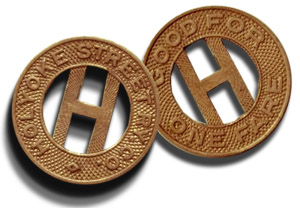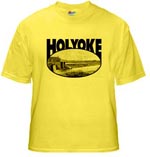by Laurel | November 9th, 2011
June, 1900
History of Railway Company
With the Dates When Numerous Extensions Were Made —
The Holyoke Street Railway Company has just bought a 10 bench open car for use as a transfer car between Mountain Park and the foot of the mountain; one of the latest models, with double tracks and the rail on the side, which is let down on a double track to keep people from getting off on the wrong side. One looking at the new car and then contrasting it in memory with the road’s first cars can scarcely believe that only 16 years have elapsed since the first little horse car ran from South Hadley Falls down South Main street on a seven-cent cash fare, on half-hour trips. The road was opened for travel to the public September 24, 1884, with four cars, and perhaps 10 horses as the motive power. There were 158 passengers carried the first day — almost two good trolley loads, and the cash value of the first day’s receipts amounted to just $9.22. Who dreamed at that time that the trolley would spread its spider arms of steel across and between most of the towns and cities of the commonwealth within 10 or 15 years? And the trolley service is just beginning, as it has not been developed at all along the lines of freight, mail and express service.
There was little to differentiate the Holyoke horse cars from those of any other small city in the state. They had the same funny little “sawed-off” shape; the driver, besides driving his horses and keeping a wary outlook for the stray passenger, saw that the fares were stuffed into the right box, and did not hesitate to tap sharply on the window to warn the absent-minded or woefully forgetful that the street railway expected that a ticket or seven cents in change would go jingling down the slot provided for it. The first president of the road was William A. Chase, afterward senator, and the greater part of the work of organization was his; so that he might perhaps be appropriately called the father of the Holyoke street railway system.
The road was opened on Saturday and we do not learn that the mental equilibrium of any of the citizens was disturbed to any extent. We can imagine that a good many who since that time have been pretty regular patrons of the system smiled rather sardonically at the likelihood of their ever investing a quarter of a dollar to ride on a horse-drawn car. Curiosity, however, must have drawn many, if nothing else; for the next day (Sunday) the receipts nearly quadrupled, and the magnificent sum of $35.18 was set down to the company’s credit. Sometimes for months after the road must have run several days at a time without making money, if not at a loss; on rainy, windy or very stormy days one or two cars would be laid off. The day of the republican rally in 1884 the receipts were $37.73 and the night of the democratic rally the receipts were $36.32, which seems to indicate that the republicans had a bigger rally or more money for riding that year than their rivals. The original strip built was run for about two years without much of any change. On June 22, 1886, the extension up Dwight street to High, down high to Appleton, and up Appleton to Beech street was built. The following November the line was extended to Lincoln street, where extensions in that direction ceased for several years.
It was the following year that the dissension arose between the South Hadley Falls selectmen and the street railway. The contention was over a matter of grade — of little account to the story, however. Feeling waxed warm, and finally the board of selectmen ignominiously buried the rails of the company in that section of the town under a heap of coal ashes and refuse. This was the last of November, and the tracks remained covered until the succeeding spring, a bus meanwhile being run by the street railway company. The company claimed that they could not make the change in grade until spring and when that season came they went ahead and made the change as intended. Probably a great moral victory was won by somebody that fall. It is very difficult for a city or town always to be found doing business on a business basis. Even our own excellent board of public works has recently sanctioned the granting of a franchise which says in one section that the “T” rail shall be laid, and in another that the grooved rail shall be the one to go down.
Some of the other extensions made were as follows: Elmwood line was opened August 9, 1889; Oakdale line, in June 1892; Mountain park, June 9, 1895; Springfield line also in 1895, and on August 13 of the same year the line to Chicopee Falls was opened. The South Hadley line was opened in 1896 and the line to Fairview in 1897, the Chicopee street line in 1898, and the past year has seen the extension of the Chicopee line to the Chicopee bridge, and the line to meet the Northampton street railway company at Smith’s Ferry, which for the present outlook will not be opened until several weeks, owing to delays by the up-the-river people. When this is completed, it is estimated that there will be 38 miles of track in operation by the Holyoke company. A few years ago the only rival that can be dignified with the name of such appeared — the People’s Railway Company, which emerged from some source and obtained a number of franchises; some believe from the inspiration of the Boston and Maine railroad. However this may be, it died a peaceful death after a time, whatever property of value that it had passing into the hands of the Holyoke company. Special notice should be called to the effect of the big blizzard of 1888. This was on March 11-12, and the Holyoke line was tied up for two weeks, cars not being run until the 23rd.
Such are a few of the facts connected with the 15-years history of the road. Succeeding W. A. Chase as president was Levi Perkins, who was succeeded late in the ’80’s by W. S. Loomis, irreverently called “Uncle Bill” by some of his opponents, who, as the president of the road is generally regarded as the “whole thing” by the people at large. If anything goes wrong President Loomis is blamed, and if the company gives him as much credit as the community does blame him for this and that, he ought to command a salary of a thousand dollars a week.
Adapted from The Springfield Republican.
Note: The tokens in the image above are in my Holyoke memorabilia collection, and the sort I remember using on the Street Railway red buses. Obviously far more contemporary than anything in this article, which focuses upon horse-drawn transportation. Article adapted from a 1900 article published in The Springfield Republican.









